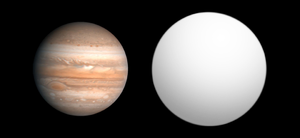WASP-13b
| Exoplanet | List of exoplanets | |
|---|---|---|
 |
||
| Parent star | ||
| Star | WASP-13 | |
| Constellation | Lynx | |
| Right ascension | (α) | 09h 20m 24.71s |
| Declination | (δ) | +33° 52′ 57.0″ |
| Distance | 510 ly (156 (± 18) pc) |
|
| Spectral type | G1V | |
| Orbital elements | ||
| Semi-major axis | (a) | 0.05379 +0.00059 −0.00077AU |
| Orbital period | (P) | 4.353011 (± 1.3e-05) d |
| Inclination | (i) | 85.64 (± 0.24)° |
| Time of transit | (Tt) | 2455575.5136 (± 0.0016) JD |
| Physical characteristics | ||
| Mass | (m) | 0.485 +0.058 −0.052MJ |
| Radius | (r) | 1.365 +0.062 −0.054RJ |
| Temperature | (T) | 1,356 K (1,083 °C; 1,981 °F) |
| Discovery information | ||
| Discovery date | April 1, 2008 | |
| Discoverer(s) | Skillen et al. (SuperWASP) | |
| Discovery method | Transit | |
| Discovery status | Published | |
| Database references | ||
| Extrasolar Planets Encyclopaedia |
data | |
| SIMBAD | data | |
| Exoplanet Archive | data | |
| Open Exoplanet Catalogue | data | |
WASP-13b is an extrasolar planet that was discovered in 2008 in the orbit of the sunlike star WASP-13. The planet has a mass of nearly half that of Jupiter, but a radius five-fourths the size of Jupiter. This low relative mass might be caused by a core that is of low mass or that is not present at all.
The planet orbits at approximately 5% of the distance between the Sun and Earth every four days. The star was observed several times between 2006 and 2009, at first through the SuperWASP program and later through focused follow-up observations. Analysis of collected radial velocity measurements led to the discovery of WASP-13b, which was reported in a journal on April 7, 2009. A follow-up study published in 2011 investigated the cause for inflated planets such as WASP-13b, and re-examined (and re-constrained) its mass, radius, density, and age.
Between November 27, 2006, and April 1, 2007, 3329 images of the star WASP-13 by the SuperWASP-North program based at Roque de los Muchachos Observatory in the Canary Islands led to the identification of WASP-13 as host to a potentially transiting object.Photometric follow-up observations were taken on February 16, 2008 using the James Gregory Telescope (JGT) in Scotland, which took 1047 exposures of the star, although the last twenty images taken were obscured by cloud cover and were discarded. Using HD 80408 as a reference star along with JGT measurements, the astronomers investigating the system were able to create a light curve for the transiting planet.
WASP-13 was observed between February 11 and 15 in 2008 by the SOPHIE échelle spectrograph at the Haute-Provence Observatory in France, determining the radial velocity of the transiting body. Use of the FIES echelle spectrograph at the Nordic Optical Telescope in the Canary Islands gained other spectral measurements that yielded the characteristics of the star. Analysis of the SOPHIE and FIES data were used to constrain some of the orbiting body's characteristics. The discovery of the orbiting body's mass using radial velocity measurements led to its confirmation as the planet WASP-13b.
...
Wikipedia
